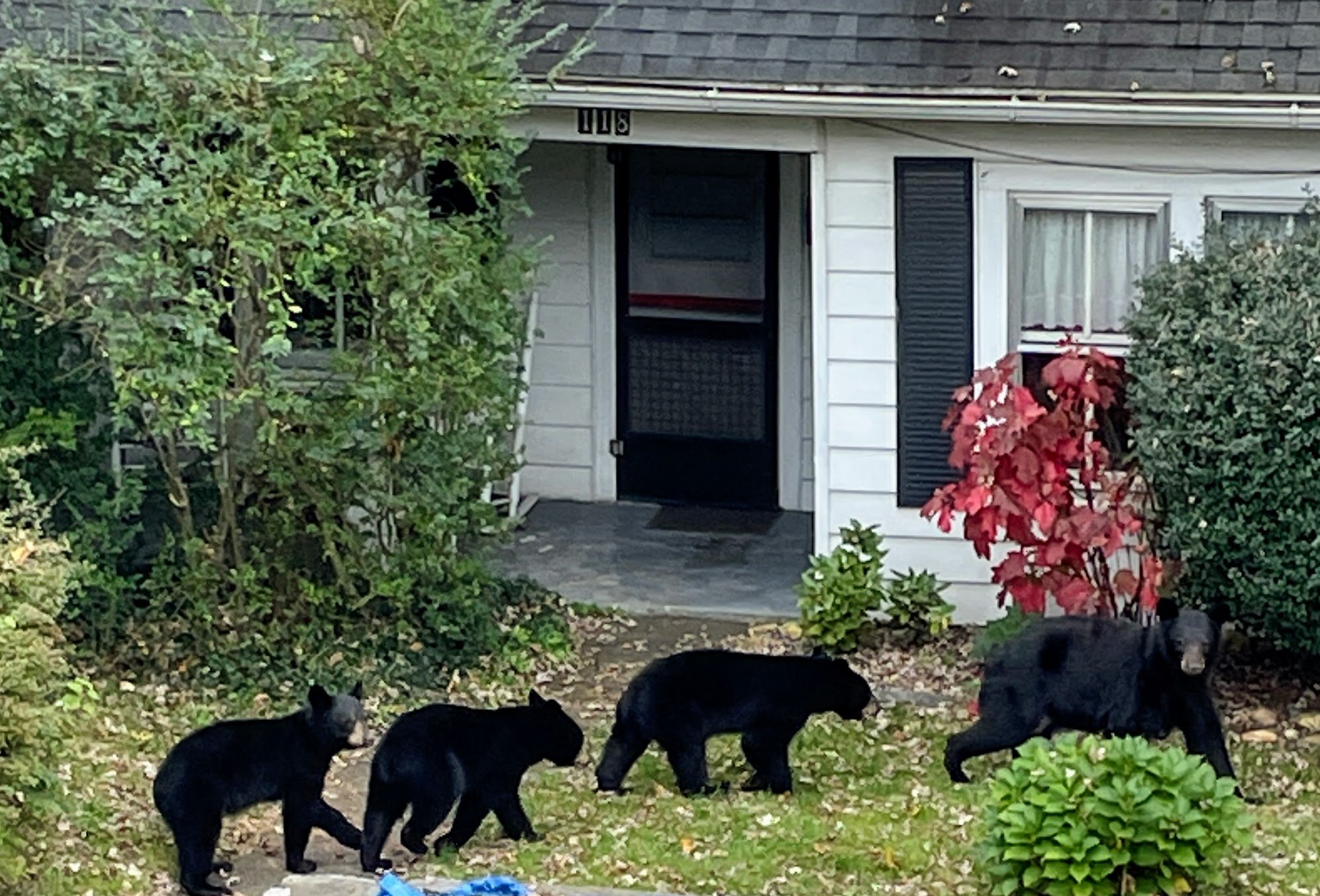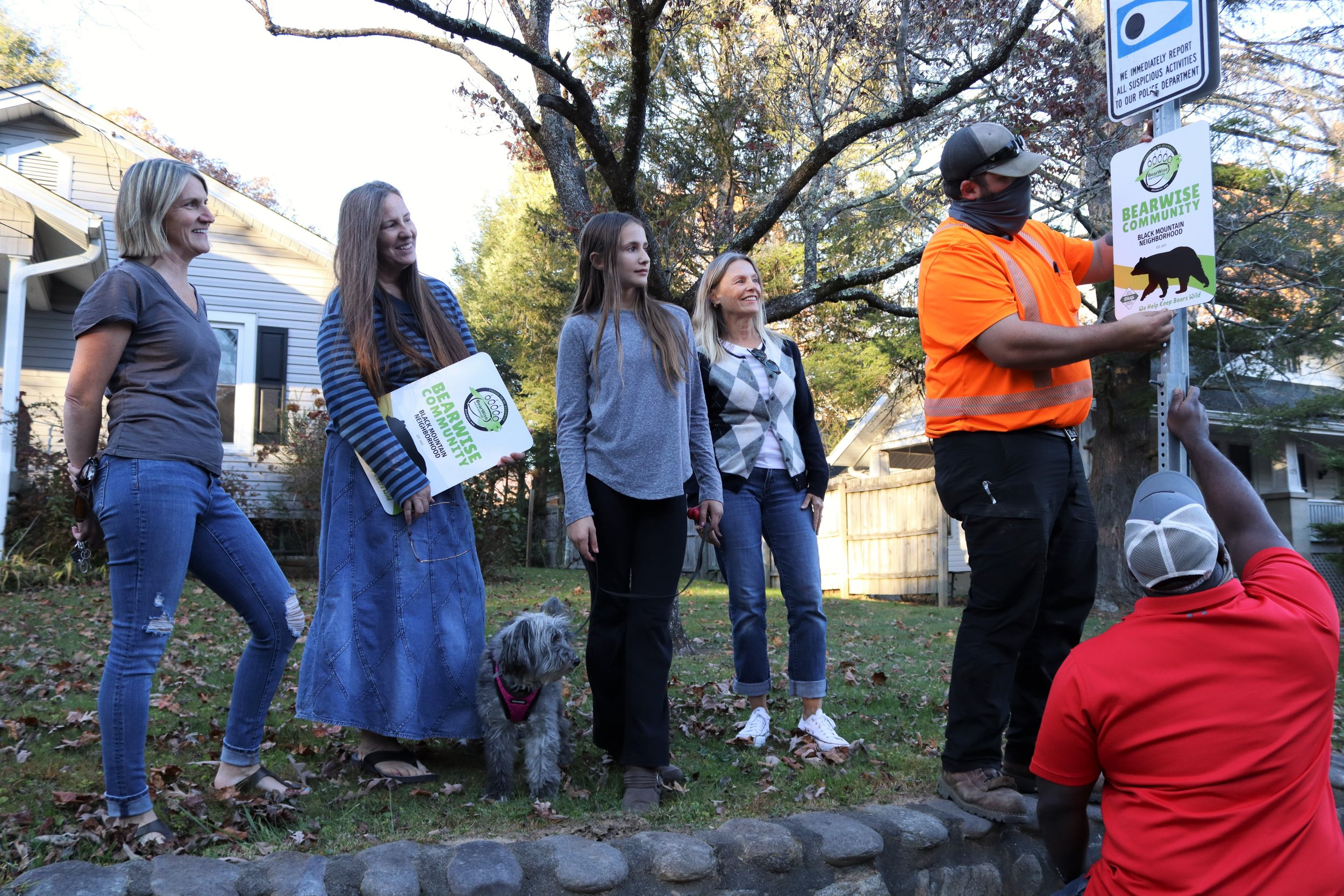Black Mountain neighborhood earns recognition as BearWise community
Local residents work to create safe environment for bears and people
Fred McCormick
The Valley Echo
November 30, 2021
Residents of a neighborhood around Fourth Street in Black Mountain hold signs recognizing the area as a BearWise community. The neighborhood was one of the first in the state to earn the designation. Pictured from left to right: Kriste Little, Amy Tripp, Shawn Slome, Kiersten Hall and Pearl Hall. Photo by Fred McCormick
The sight of an American black bear lumbering through a quiet neighborhood is a familiar one in Western North Carolina. Once confined to the isolated areas of the mountains, the species has made a remarkable comeback since its population in the region dwindled in the early 20th century.
Today, as the number of bears and humans living in the area continues to climb, the need to establish a healthy and sustainable environment for them to coexist grows each year. One Black Mountain neighborhood is taking a proactive approach to living responsibly with their wild four-legged neighbors by partnering with the N.C. Wildlife Resources Commission to become one of the first BearWise communities in the state.
Just blocks away from historic downtown, residents of Third Street, Fourth Street, Louisa Street and Portman Villa Road have been observing the animals wandering through their yards, driveways and streets for years. While an occasional migratory stroll through an urban environment is typical bear behavior, a lingering presence is cause for concern.
“Around three years ago, I started to notice the bear activity in our backyard was escalating,” said Kiersten Hall, whose family has lived in the neighborhood for more than a decade. “They were there during the day, not just passing through, but camping out. So, I started looking for information.”
Hall discovered BearWise, a program launched by black bear biologists in the southeastern U.S. in 2018. The initiative, supported by state wildlife agencies, provides educational resources, safety tips and a wide variety of helpful information about living in close proximity to bears. Its website, bearwise.org, offers a five-step process to creating a BearWise community.
Hall inquired about the program after one of the animals attempted to interact with a small child who was inside her home at the time.
“I put in a call to (NCWRC) after that incident, because it scared us, and a lead biologist came out to our house,” she said. “He did an assessment of our yard, which is something they’ll do if you’re having bear problems. I asked him if he thought we should consider the BearWise program, and he thought our community was a good fit.”
Wising up about bears
Hall and her neighbors were introduced to NCWRC Assistant Black Bear Biologist and Furbearer Ashley Hobbs, who works to educate people about how to live responsibly around the animals.
“One of those educational resources is the BearWise program, particularly in places like Asheville, and the surrounding urban environments,” she said. “The bear managers in the southeastern U.S. wanted to create a program that had consistent messaging that’s based in science. So the overarching goal is whether you have a beach house in Florida, or a mountain house in N.C., you get the same message on how to coexist with black bears.”
A family of black bears strolls through a yard on Third Street in Black Mountain. Photo courtesy of Shawn Slome
Approximately 72,000 black bears, and 124 million humans were living in the 15 states that comprise BearWise’s region of focus, as of 2019. N.C., with an estimated 17,000 - 20,000, has the largest black bear population of any of them. While the species is primarily concentrated in the state’s coastal and mountainous areas, Buncombe County accounts for somewhere between 33% - 66% of the bear-related calls in N.C. every year, according to Hobbs.
“We’re not necessarily seeing an increase in the overall number of calls,” she said. “But, we’re seeing an increase in calls about escalated bear behavior. We’re hearing more reports of bears coming into garages or closer to the home, and not being scared away.”
As more people move to the area, Hobbs continued, the likelihood that bears will be attracted to urban environments increases.
“Some people love seeing the bears too much, and they’ll feed them to get them to come into their yards. Ultimately, that does more harm to the bears because it doesn’t set boundaries that allow them to recognize it’s not good to come around human developments,” Hobbs said. “We have a bear population that was around 1,000 in 1950, and now we’re close to 20,000, so when you introduce lots more people and lots more bears, there’s going to be a lot more interaction.”
The BearWise program, according to the biologist, promotes habits that support a healthy environment for bears and residents.
“The goal is to keep bears wild, and keep people safe,” Hobbs said.
Given her experience, and those of her neighbors, that prospect was appealing to Hall.
“We do live in bear country, and we have a very healthy population here,” she said. “Because the bears get more caloric intake from our garbage, and bird feeders, they’ve altered their behavior. They’re very habitual, so when they find a new source of food, they will stick with it until it’s gone.”
Longtime residents of the neighborhood often know what to expect when a bear is spotted in the area, but Amy Tripp, who moved to Black Mountain from Florida a year ago, had no previous experience living around the animals.
“We moved here last September, and we were introduced to them the first week,” she said. “They were active at the time, and they got into my neighbor’s garbage.”
Tripp represents one of approximately 35 households in the neighborhood who participate in the BearWise program.
“I really like it because it’s an education program that helps us understand how to keep bears wild,” she said. “I believe when you know better, you do better, and this process taught us how to create a better environment for the bears, and ourselves.”
The neighborhood formed two committees to organize the BearWise recognition process, with one focusing on education, and the other keeping track of bear activity in the immediate area. They began meeting with Hobbs, virtually, in 2020.
“We learned the basic information about BearWise, what our neighborhood needed to do and how long it would take,” Hall said. “She also introduced us to the BearWise Basics, which are six things that communities implement to live safely with bears.”
The six at-home basics of BearWise advise residents to: never feed or approach bears; secure food, garbage and recycling; remove bird feeders when bears are active; never leave pet food outdoors; clean and store grills and alert neighbors to bear activity.
Adhering to the practices eliminates the smells and potential food sources that attract the animals, which possess an acute sense of smell that can detect scents from a mile away. Residents from the neighborhood distributed door hangers and hosted block parties to help spread the word.
The neighborhood was officially recognized as a BearWise community in the summer of 2021, and a community website allowing residents to report nearby bear activity was launched. The online forms, which are submitted directly to the NCWRC, include three observable categories of behavior: normal, concerning and threatening.
Normal behaviors include a bear spotted in the distance, or one that is easily scared away, while concerning behaviors range from the animal entering an open garage to leaving nose or paw prints on windows and doors. Behaviors that are considered “threatening” involve a bear attempting to enter an occupied home, following people or making physical contact with them.
The Black Mountain neighborhood was one of the first in the state to be recognized as a BearWise community, according to Hobbs.
“As a program, BearWise started in 2018, but it wasn’t until 2019 when we really began outreach to neighborhoods in N.C.,” she said. “But, once COVID-19 hit, it kind of derailed it a bit. So, when you factor in the pandemic, this is very much a new program.”
Two neighborhoods in the Town Mountain area of Asheville completed the process earlier this year, Hobbs continued, while the Town of Highlands was recognized as a BearWise community in October.
Hall and her neighbors gathered on Fourth Street in early November as public works employees from the Town of Black Mountain installed a pair of signs recognizing their neighborhood as a BearWise community. They hope their efforts will motivate other Swannanoa Valley neighborhoods to participate in the program.
BearWise beyond the neighborhood
Observing the six basics of BearWise yielded positive results for Hall and her neighbors, who haven’t reported any bear-related garbage disturbances since they began participating in the program. The work to educate others about coexisting with bears continues, however.
“One of the things we wanted to do when we started this process was to use our experience as a springboard for the BearWise movement in the entire town,” said Hall, who hosted five informational booths at the Black Mountain Tailgate Market, along with neighbors and NCWRC biologists in the summer and fall. “We had a lot of people who were happy to see us there, and a lot of people commented that we needed to have access to more bear information in our town.”
Town of Black Mountain public works employees install a BearWise sign on Fourth Street, as residents of the neighborhood look on. Photo by Fred McCormick
While some local residents have adapted to living around bears, many of the tourists who visit when the animals are most active can be unaware of their presence.
“There are so many people who pass through here who really don’t understand how to cohabitate with bears,” Hall said. “So, getting the word out about the BearWise basics is a good way to help raise everyone’s awareness.”
The resilience and adaptability of black bears has allowed the species to thrive in the mountains of WNC, where their population increases at a rate of approximately 5% each year, according to Hobbs, who adds that a proactive approach to living with the animals is better than a reactive one.
“If we can have contiguous areas practicing BearWise, we will see the bears that are hanging out in those areas learn new behaviors that don’t target human sources of food, like garbage or bird feeders,” Hobbs said. “It’s not that we’re looking to never see bears again, because you can practice BearWise perfectly and still see them moving through your neighborhood. But, once those bears start to stick around, it becomes an issue.
“The more people we can get to practice BearWise on a community scale, the less likely we are to see the negative impacts of bears hanging around people’s homes,” she said.
For more information on BearWise, visit bearwise.org.



